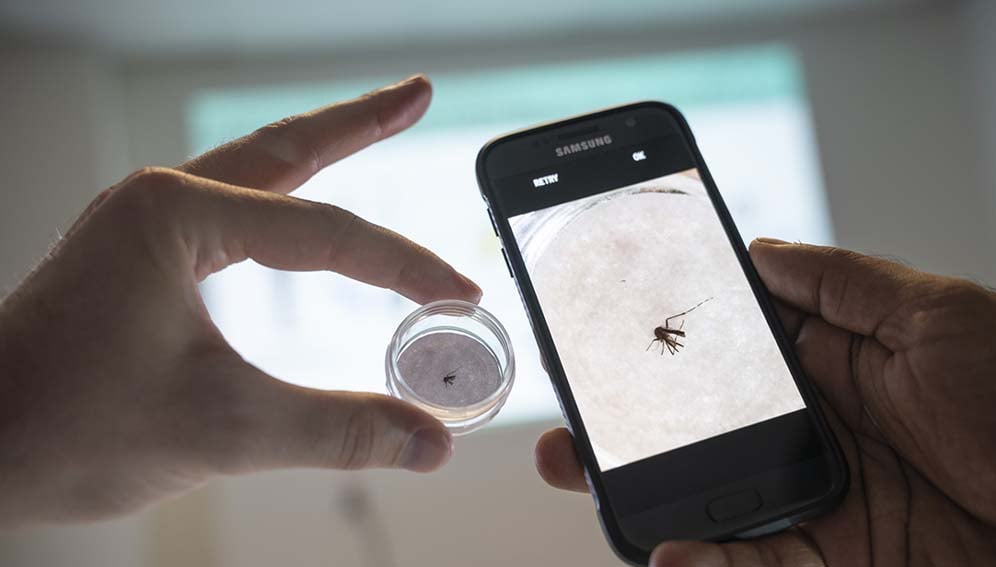By: Dann Okoth
Send to a friend
The details you provide on this page will not be used to send unsolicited email, and will not be sold to a 3rd party. See privacy policy.
[NAIROBI, SciDev.Net] Researchers say they have used Artificial Intelligence and citizen-submitted photos to identify what they believe was the first Anopheles stephensi detected in Madagascar, amid a rising threat from the malaria-transmitting mosquito across Africa.
The World Health Organization (WHO) has identified the spread of Anopheles stephensi as a significant threat to malaria control and elimination, particularly in Africa.
Researchers say the findings, published in the journal Insects, show how local communities and digital technology can be mobilised to fill gaps in the surveillance of this species, especially in hard to monitor urban areas.
The finding was made after a single smartphone photo was submitted by residents of Madagasar’s capital Antananarivo through the GLOBE Observer, a citizen science app developed by US space agency NASA.
The close-up photo showed a mosquito larva collected from a tyre in the city. It was taken in 2020 but only discovered two years later when scientists were reviewing historical data, amid concerns about the spread of Anopheles stephensi, says lead author Ryan Carney.
After taking thousands of smartphone photos of verified Anopheles stephensi and other endemic species, and training AI image recognition algorithms, the team developed a citizen science tool for Anopheles stephensi detection.
This was able to confirm the species of the larva spotted five years ago, according to the researchers who say it shows the potential for citizen science and AI to help combat the invasive species.
Citizen-generated photos can provide early-warning data, helping authorities identify new or expanding populations more quickly than conventional trapping alone, according to Carney.
“Traditional mosquito surveillance such as trapping is expensive, requires expertise and time, and is not easily scalable, especially across jurisdictional boundaries,” he told SciDev.Net.
“Citizen science should thus be a priority for both local communities and international health bodies like the WHO to complement ongoing Anopheles stephensi surveillance measures in hard-to-reach and densely populated regions.”
Anopheles stephensi is particularly susceptible to the malaria parasite and highly resistant to pesticides.
It thrives in cities, breeding in artificial containers such as tyres and buckets, allowing it to sustain year-round malaria transmission in densely populated areas.
A previous study indicated its spread could put an additional 126 million people at risk of malaria across Africa.
The researchers point to three freely available apps—iNaturalist, Mosquito Alert and NASA’s GLOBE Observer—as effective tools for scaling mosquito monitoring in African countries. All are accessible globally and offer multiple language options, including Swahili and Arabic, which may support wider community engagement.
Citizen scientists equipped with a smartphone and a 60x magnifying clip-on lens can submit close-up photos of a mosquito or its larvae to the apps for verification.
Carney says local health ministries and mosquito control programmes can make use of the Global Mosquito Observations Dashboard, which aggregates mosquito photos and location data from around the world. This allows officials to identify areas that may require targeted surveillance or control efforts.
Andrianjafy Mbolatiana, an entomologist at the University of Antananarivo, says the technology has practical value in Madagascar.“We lack sufficient financial and human resources to monitor vector-borne diseases such as malaria,” he told SciDev.Net.
“This technology complements the standard surveillance method and will help us detect and prevent invasive and dangerous species, such as Anopheles stephensi.”
But he adds that many Malagasy people, indigenous to Madagascar, do not have smartphones or reliable internet, which may limit participation.
Researchers behind the study also acknowledge clear limitations.
“For these tools, one of the limitations is that people are simply unaware that the citizen science apps exist or that photos of mosquitoes are needed by scientists,” said Carney, whose team created the InAfrica.org campaign to boost participation.
The technical requirements could also be a barrier.
“The photos must be taken with that 60x clip-on lens for the AI results to be valid, since the AI algorithms were trained on only this type of photos,” said Carney.
To improve uptake, researchers recommend that public health agencies and malaria control programmes support citizen scientists in obtaining the correct lens and help raise awareness of the technology.
Mohga Kamal-Yanni, global health and access-to-medicines consultant at The People’s Medicines Alliance, believes placing tools directly in community hands is important for tackling malaria from the ground up, at a time when Africa is being hit hard by international aid cuts.
She told SciDev.Net: “For decades Africa has relied on foreign aid to tackle disease, including disease surveillance and control.
“But with cuts in international aid […it has] left a huge gap in the continent which needs to be filled through other means such as the citizen scientists approach.”
This piece was produced by SciDev.Net’s Sub-Saharan Africa English desk



